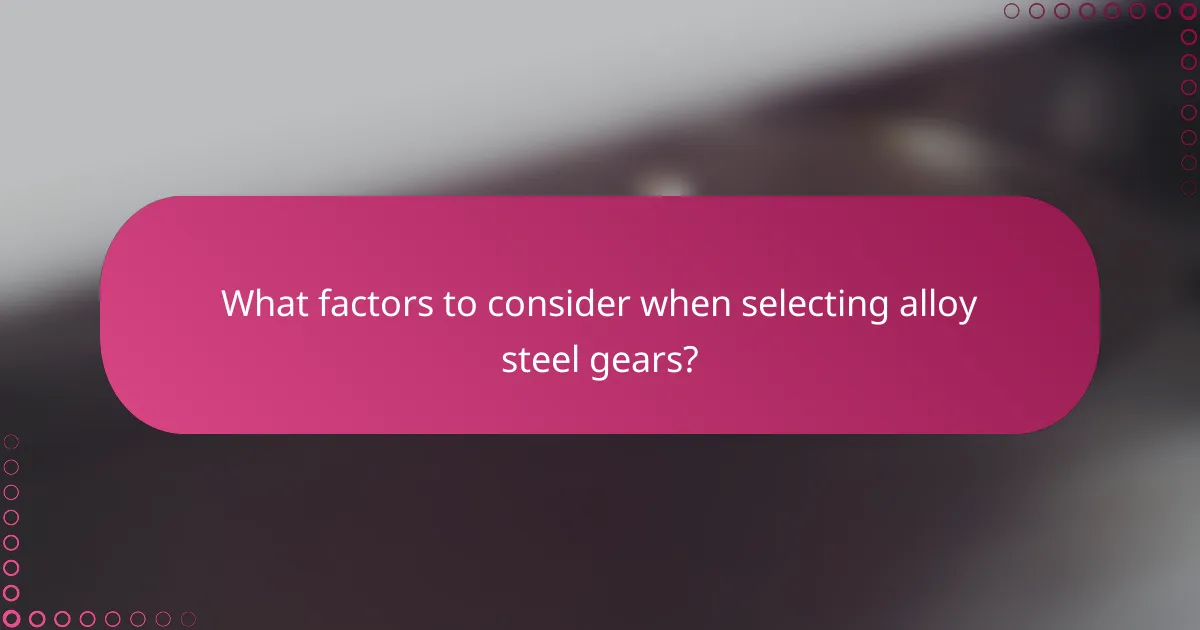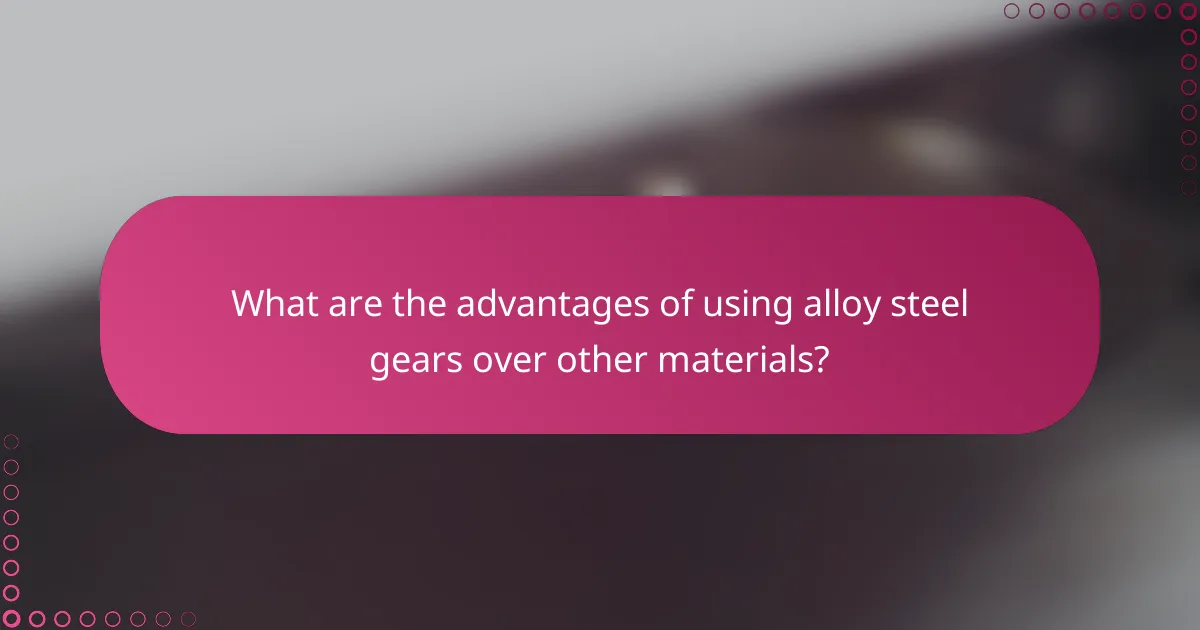Alloy steel gears play a crucial role in both automotive transmissions and industrial machinery, offering a blend of strength, durability, and performance. Their superior mechanical properties enable them to withstand high stress and demanding conditions, making them ideal for a variety of applications. When selecting these gears, it’s essential to consider factors such as material grade, compatibility, and load capacity to ensure optimal performance and efficiency.

What are the best alloy steel gears for automotive transmissions?
The best alloy steel gears for automotive transmissions are those that provide a balance of strength, durability, and performance. Key factors include the specific application, desired gear ratios, and compatibility with the vehicle’s drivetrain.
Ford Performance alloy steel gears
Ford Performance offers a range of alloy steel gears designed to enhance the performance of Ford vehicles. These gears are engineered for strength and precision, making them suitable for both street and track applications. Popular options include the 8.8-inch rear end gears, which are available in various ratios to suit different performance needs.
When selecting Ford Performance gears, consider the intended use of the vehicle. For instance, lower gear ratios can improve acceleration, while higher ratios may enhance fuel efficiency at cruising speeds.
Chevrolet Performance alloy steel gears
Chevrolet Performance provides high-quality alloy steel gears tailored for various Chevy models. These gears are built to withstand the demands of performance driving, offering options for both classic and modern vehicles. The 10-bolt and 12-bolt rear differentials are popular choices, with multiple gear ratios available to optimize performance.
Choosing the right Chevrolet Performance gears involves assessing your vehicle’s power output and intended driving style. For example, a higher gear ratio can lead to quicker acceleration, while a lower ratio may be better for highway driving.
Gear ratios for optimal performance
Gear ratios play a crucial role in determining the performance characteristics of a vehicle’s transmission. A lower gear ratio (numerically higher) typically provides better acceleration, while a higher gear ratio (numerically lower) can improve fuel efficiency and top speed. Understanding the trade-offs between these ratios is essential for optimizing vehicle performance.
For most performance applications, a common range for gear ratios is between 3.55 and 4.10, depending on the vehicle and its intended use. It’s advisable to consult with a performance specialist to determine the best ratio for your specific setup, ensuring compatibility with engine power and driving conditions.

How do alloy steel gears improve industrial machinery?
Alloy steel gears enhance industrial machinery by providing superior mechanical properties, which lead to increased efficiency and reliability. These gears are engineered to withstand high stress and demanding operational conditions, making them ideal for various applications.
Enhanced durability and strength
Alloy steel gears are known for their exceptional durability and strength, which are critical in heavy-duty applications. The addition of elements like chromium and nickel improves the tensile strength and impact resistance, allowing these gears to perform reliably under high loads.
In practical terms, this means that machinery utilizing alloy steel gears can operate longer without failure, reducing downtime and maintenance costs. For example, in automotive transmissions, these gears can handle the torque demands of modern engines more effectively than standard steel gears.
Resistance to wear and corrosion
One of the significant advantages of alloy steel gears is their resistance to wear and corrosion. The alloying elements enhance the surface hardness, which minimizes wear during operation, while also providing protection against rust and environmental factors.
This resistance is particularly beneficial in industrial settings where exposure to moisture and chemicals is common. For instance, gears used in manufacturing equipment can maintain their performance and integrity over time, leading to lower replacement rates and improved productivity.
Cost-effectiveness in long-term use
While alloy steel gears may have a higher initial cost compared to standard gears, their long-term cost-effectiveness is evident through reduced maintenance and replacement needs. The durability and resistance to wear mean fewer failures and less frequent repairs.
Businesses can benefit from this investment by experiencing lower operational costs over time. For example, industries that rely on continuous operation, such as automotive or heavy machinery, can see significant savings by choosing alloy steel gears, as they extend the lifespan of the equipment and enhance overall efficiency.

What factors to consider when selecting alloy steel gears?
When selecting alloy steel gears, consider material grade, compatibility with existing systems, and load capacity. These factors significantly influence performance, durability, and overall efficiency in applications like automotive transmissions and industrial machinery.
Material grade and specifications
The material grade of alloy steel gears affects their strength, wear resistance, and machinability. Common grades include 4140 and 4340, which offer good toughness and fatigue resistance. Always refer to industry standards, such as ASTM or ISO, to ensure the selected grade meets the specific application requirements.
Specifications like hardness, tensile strength, and impact resistance should align with operational demands. For example, gears operating under high stress may require higher hardness levels to prevent deformation. Consult technical data sheets for precise information on the material properties.
Compatibility with existing systems
Ensuring compatibility with existing systems is crucial for seamless integration. This includes checking dimensions, tooth profiles, and mounting configurations. Mismatched specifications can lead to operational inefficiencies or mechanical failures.
Evaluate the existing gear system’s design and performance characteristics. For instance, if the current gear system uses metric dimensions, ensure the new alloy steel gears are also metric to avoid fitting issues. Conducting compatibility tests can help identify potential problems before installation.
Load capacity and torque requirements
Load capacity and torque requirements are vital for selecting the right alloy steel gears. Assess the maximum loads and torque that the gears will experience during operation. This information helps determine the appropriate gear size and material grade needed to handle the stresses without failure.
Use guidelines from manufacturers or industry standards to calculate the necessary load ratings. For instance, gears in automotive applications may need to withstand dynamic loads in the range of hundreds to thousands of Newtons, depending on the vehicle type and driving conditions. Regularly review these requirements to ensure ongoing performance and safety.

What are the common applications of alloy steel gears?
Alloy steel gears are widely used in various industries due to their strength, durability, and resistance to wear. Common applications include heavy machinery, automotive systems, and aerospace components, where reliability and performance are critical.
Heavy machinery in construction
In construction, alloy steel gears are essential for heavy machinery such as excavators, bulldozers, and cranes. These gears endure high loads and harsh conditions, making their strength and wear resistance vital for operational efficiency.
When selecting gears for heavy machinery, consider factors like load capacity, environmental conditions, and maintenance requirements. Regular inspections can help prevent failures and extend gear life.
Automotive drivetrain systems
Alloy steel gears play a crucial role in automotive drivetrain systems, including manual and automatic transmissions. Their ability to withstand high torque and stress ensures smooth power transfer from the engine to the wheels.
In automotive applications, it’s important to choose gears that meet specific performance standards, such as those set by the Society of Automotive Engineers (SAE). Proper lubrication and alignment are also key to maximizing gear longevity.
Aerospace engineering components
In aerospace engineering, alloy steel gears are used in various applications, including landing gear mechanisms and actuation systems. The lightweight yet strong properties of these gears are essential for maintaining safety and performance in flight.
When designing aerospace components, adherence to strict regulations and standards, such as those from the Federal Aviation Administration (FAA), is critical. Regular testing and quality assurance processes help ensure reliability and safety in aerospace gear applications.

How to maintain alloy steel gears for longevity?
To ensure the longevity of alloy steel gears, it is essential to follow a consistent maintenance routine that includes lubrication, inspection, and proper installation. These practices help prevent premature wear and enhance the performance of gears in automotive transmissions and industrial machinery.
Regular lubrication practices
Regular lubrication is crucial for maintaining alloy steel gears, as it reduces friction and wear. Use high-quality lubricants specifically designed for gear applications, and follow the manufacturer’s recommendations for viscosity and type.
Establish a lubrication schedule based on the operating conditions, such as load and temperature. For most applications, lubricating every few hundred operating hours is a good starting point, but this may vary depending on specific usage.
Inspection for wear and tear
Routine inspections are vital for identifying wear and tear on alloy steel gears. Look for signs such as pitting, scoring, or unusual noise during operation, which can indicate potential issues.
Conduct visual inspections at regular intervals, and consider using tools like micrometers to measure gear tooth wear. Addressing minor issues early can prevent costly repairs or replacements down the line.
Proper alignment and installation
Proper alignment and installation of alloy steel gears are essential for optimal performance and longevity. Misalignment can lead to uneven wear and increased stress on the gears, potentially causing failure.
Use alignment tools and techniques to ensure that gears are installed correctly. Follow the manufacturer’s specifications for installation to avoid common pitfalls, such as over-tightening or incorrect spacing, which can compromise gear integrity.

What are the advantages of using alloy steel gears over other materials?
Alloy steel gears offer significant advantages over other materials, primarily due to their enhanced mechanical properties. These gears are known for their strength, durability, and resistance to wear, making them ideal for demanding applications in automotive transmissions and industrial machinery.
Higher tensile strength
Alloy steel gears exhibit higher tensile strength compared to gears made from standard steel or plastic. This increased strength allows them to withstand greater loads and stresses without deforming or breaking, which is crucial in high-performance applications like automotive gearboxes.
For instance, alloy steel gears can handle tensile strengths ranging from 700 to 1,200 MPa, making them suitable for heavy-duty machinery. This capability reduces the risk of gear failure, ensuring reliable operation in critical systems.
Better heat resistance
Alloy steel gears are designed to endure higher temperatures without losing their structural integrity. This heat resistance is essential in environments where friction generates significant heat, such as in automotive transmissions during acceleration.
Typically, alloy steel can maintain its properties at temperatures exceeding 300°C, unlike standard materials that may soften or warp. This characteristic helps prevent gear failure and prolongs the lifespan of the components in high-temperature applications.
Improved fatigue resistance
Fatigue resistance is another key advantage of alloy steel gears, allowing them to endure repeated stress cycles without cracking or failing. This property is particularly important in applications where gears are subjected to continuous loading and unloading, such as in industrial machinery.
Alloy steel gears often have a fatigue limit that can be significantly higher than that of other materials, which means they can operate effectively over a longer period. This durability leads to reduced maintenance costs and less downtime, making them a cost-effective choice in the long run.


